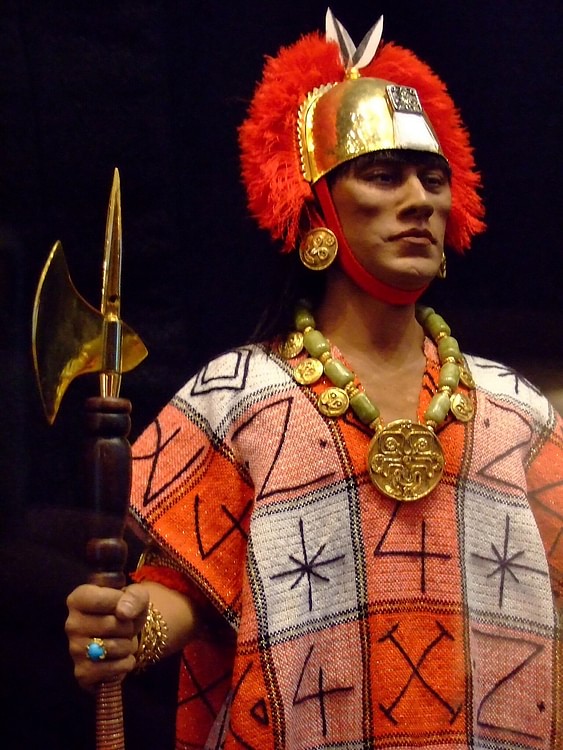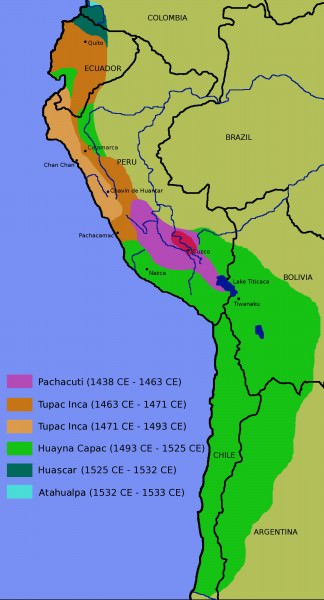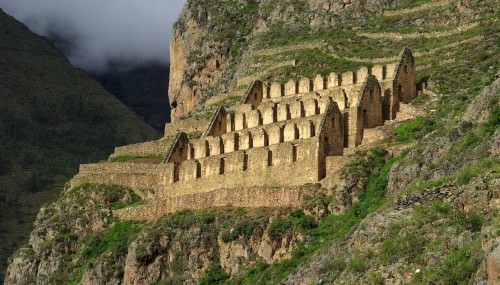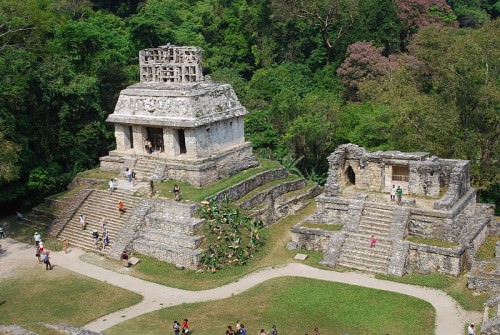Inca Government › Early Explorers of the Maya Civilization » Ancient origins
Articles and Definitions › Contents
- Inca Government › Ancient History
- Early Explorers of the Maya Civilization: From Aguilar to Waldek › Antique Origins
Ancient civilizations › Historical and archaeological sites
Inca Government › Ancient History
Definition and Origins

The Inca civilization flourished in ancient Peru between c. 1400 and 1534 CE, and their empire eventually extended across western South America from Quito in the north to Santiago in the south, making it the largest empire ever seen in the Americas. Government and power was held at Cuzco, the Inca capital, which was considered the navel of the world.Eventually 40,000 Incas would govern some 10 million subjects speaking over 30 different languages. Consequently, the centralised Inca government, employing a vast network of administrators, governed over a patchwork empire which, in practice, touched local populations to varying degrees. Inca government, therefore, relied heavily on a combination of personal relations, state largesse, ritual exchange, law enforcement and military might.
HISTORICAL OVERVIEW – THE EMPIRE
Cuzco became a significant centre sometime at the beginning of the Late Intermediate Period (1000-1400 CE). A process of regional unification began from the late 14th century CE, and from the early 15th century CE, with the arrival of the first great Inca leader Pachacuti ('Reverser of the World'), the Incas began to expand in search of plunder and production resources, first to the south and then in all directions, and so they built an empire which stretched across the Andes.
The rise of the Inca Empire was spectacularly quick. First, all speakers of the Inca language Quechua (or Runasimi) were given privileged status, and this noble class then dominated all the important roles within the empire. Eventually a nationwide system of tax and administration was instigated which consolidated the power of Cuzco. The Incas themselves called their empire Tawantinsuyo (or Tahuantinsuyu) meaning 'Land of the Four Quarters'.
THE INCAS IMPOSED THEIR RELIGION, ADMINISTRATION, AND EVEN ART ON CONQUERED PEOPLES.
THE INCA KING
The Incas kept lists of their hereditary kings (Sapa Inca, meaning Unique Inca) so that we know of such names as Pachacuti Inca Yupanqui (reign c. 1438-63 CE), Thupa Inca Yupanqui (reign c. 1471-93 CE), and Wayna Qhapaq (the last pre-Hispanic ruler, reign c. 1493-1525 CE). It is possible that two kings ruled at the same time and that queens may have had some significant powers, but the Spanish records are not clear on both points. The king was expected to marry on his accession, his bride sometimes being his own sister. The queen ( Qoya ) was known as Mamancik or 'Our Mother' and could wield some influence both on her husband and via her kin group, particularly in selecting which son might become the official heir to the throne. The Qoya also had significant wealth of her own which she could dispose of as she wished.
The Sapa Inca was an absolute ruler whose word was law. He controlled politics, society, the empire's food stores, and he was commander-in-chief of the army. Revered as a god he was also known as Intip Churin or 'Son of the Sun'. Given this elevated status he lived a life of great opulence. Drinking from gold and silver cups, wearing silver shoes, and living in a palace furnished with the finest textiles, he was pampered to the extreme. He was even looked after following his death as the Inca mummified their rulers and later 'consulted' them for their opinion on pressing state affairs. Despite his enviable status, though, the king had to negotiate the consent and support of his nobles who could, and did, sometimes depose or even assassinate their ruler. In addition to keeping favour with his nobles the king also had to perform his role as a magnanimous benefactor to his people, hence his other title Huaccha Khoyaq or 'Lover and Benefactor of the Poor'.

Map of the inca Empire
THE INCA NOBLES
Inca rule was, much like their famous architecture, based on compartmentalised and interlocking units. At the top was the king, his high priest ( Willaq Umu ) – who could also act as a field marshal - and ten royal kindred groups of nobles called panaqa.These nobles could form and instigate policy in councils with the king and, even more importantly, influence the final choice of the king's successor which was rarely simply the eldest son. Indeed, many royal accessions were preceded by intrigue, political maneuvering, coups, and even assassinations to promote a particular kin group's candidate. This may well be why later Inca kings married their own sister so as to avoid widening the elite power base at the very top of the government structure.
Next in line to the panaqa came ten more kindred groups more distantly related to the king and divided into two halves: Upper and Lower Cuzco. Then came a third group of nobles not of Inca blood but made Incas as a privilege. This latter group was drawn from that section of the population which had inhabited the region when the Incas had first arrived. As all of these groups were composed of different family lines, there was a great deal of rivalry between them which sometimes broke out into open warfare.
THE INCA ADMINISTRATORS
At the bottom of the state apparatus were locally recruited administrators who oversaw settlements and the smallest Andean population unit the ayllu, which was a collection of households, typically of related families who worked an area of land, lived together, and provided mutual support in times of need. Each ayllu was governed by a small number of nobles or kurakas, a role which could include women.
Local administrators collaborated with and reported to over 80 regional-level administrators (a tokrikoq ) who were responsible for such matters as justice, censuses, land redistribution, organizing mobile labour forces, and maintaining the vast network of roads and bridges in their jurisdiction. The regional administrators, who were almost always ethnic Incas, reported to a governor responsible for each quarter of the empire. The four governors reported to the supreme Inca ruler in Cuzco. To ensure loyalty, the heirs of local rulers were also kept as well-kept prisoners at the Inca capital. The most important political, religious, and military roles within the empire were, then, kept in the hands of the Inca elite, called by the Spanish the orejonesor 'big ears' because they wore large earspools to indicate their status. To better ensure the control of this elite over their subjects, garrisons dotted the empire and entirely new administrative centres were built, notably at Tambo Colorado, Huanuco Pampa and Hatun Xauxa.

Inca Qollqa
TAXATION & TRIBUTE
For tax purposes annual censuses were regularly taken to keep track of births, deaths, marriages, and a worker's status and abilities. For administrative purposes populations were divided up into groups based on multiples of ten (Inca mathematics was almost identical to the system we use today), even if this method did not always fit the local reality. These censuses and the officials themselves were examined every few years, along with provincial affairs in general, by dedicated and independent inspectors, known as a tokoyrikoq or 'he who sees all'.
As there was no currency in the Inca world taxes were paid in kind - usually foodstuffs (especially maize, potatoes, and dried meat), precious metals, wool, cotton, textiles, exotic feathers, dyes, and spondylus shell - but also in labourers who could be shifted about the empire to be used where they were most needed. This labour service was known as mit'a. Agricultural land and herds were divided into three parts: production for the state religion and the gods, for the Inca ruler, and for the farmers' own use. Local communities were also expected to help build and maintain such imperial projects as the road system which stretched across the empire. To keep track of all these statistics the Inca used the quipu, a sophisticated assembly of knots and strings which was also highly transportable and could record decimals up to 10,000.
Goods were transported across the empire along purpose-built roads using llamas and porters (there were no wheeled vehicles). The Inca road network covered over 40,000 km and as well as allowing for the easy movement of armies, administrators, and trade goods it was also a very powerful visual symbol of Inca authority over their empire.
COLLAPSE
The Inca Empire was founded on, and maintained, by force and so the ruling Incas were very often unpopular with their subjects (especially in the northern territories), a situation that the Spanish conquistadores, led by Francisco Pizarro, would take full advantage of in the middle decades of the 16th century CE. Rebellions were rife, and the Incas were actively engaged in a war in Ecuador, where a second Inca capital had been established at Quito, just at the time when the empire faced its greatest ever threat. Also hit by devastating diseases brought by the Europeans and which had actually spread from Central America faster than their Old World carriers, this combination of factors would bring about the collapse of the mighty Inca civilization before it had even had chance to fully mature.
Early Explorers of the Maya Civilization: From Aguilar to Waldek › Antique Origins
Ancient Civilizations
Although John Lloyd Stephens and Frederick Catherwood are consistently credited with the `discovery' of the Maya Civilization, there were many who preceded them who sparked their interest in making their famous travels through Mesoamerica. The first non- Maya to explore the sites were Catholic priests who, many years after the Spanish Conquest of the region in the 16th century, visited the empty cities and told others about them. In 1695 the Friar Andres de Avendano y Loyola wrote extensively about the Maya and his missionary efforts in converting them to Christianity. In doing so, he gave early accounts of their culture, book making, religious beliefs and daily life. He also makes mention of certain sites, though not by recognizable names, which suggests that not every city was abandoned c. 950 CE but that some were re-inhabited. Even so, Avendano's accounts are biased in that he saw the Maya as deceptive heathens in need of salvation (Houston,et.al., 42).In 1773 the Father Ramon Ordonez de Aguilar wrote of the Maya of Palenque but so conflated stories he had heard with other accounts given by the Bishop Nunez de la Vega that his work is more mythology than fact. It is from Aguilar's efforts that the modern day belief in a non-existent Mayan god named `Votan' spring but, more significantly, the idea that the builders of the great cities of Mesoamerica came from the Middle East. According to Aguilar, Votan was the founder of Palenque and a great hero who traveled regularly to unspecified lands in the `old world' around Egypt and Palestine. Other works, or fragments of works, by priests and missionaries who had contact with the Maya display the same sort of fanciful interpretation of the people and their abandoned cities.

Temple of the Sun, Palenque
Aguilar's treatise motivated the Lieutenant Esteban Gutierrez to mount an expedition to Palenque in 1773 which inspired others to then do the same. These expeditions interested the Administrator Jose de Estacheria who sent Lieutenant Jose Antonio Calderon to Palenque in 1784. After receiving his report, Estacheria dispatched the Italian architect Bernasconi, under the auspices of the Spanish government, to the site. Bernasconi arrived in Palenque in 1785 to document and report on the city. In response to his report, the King of Spain sent Antonio del Rio to excavate Palenque in 1787 in the company of the artist Ricardo Armendariz and this is considered the first methodologically sound expedition to a Mayan site (Drew, 37-45).Armendariz's drawing of the ruins were the first glimpse the world had of the Maya Civilization.
ARMENDARIZ'S DRAWING OF THE RUINS WERE THE FIRST GLIMPSE THE WORLD HAD OF THE MAYA CIVILIZATION.
Following del Rio's report, interest in the region grew and a number of other expeditions to `New Spain' were launched; among them that of Dupaix and Castaneda who were the first to produce a work of text accompanied by illustrations of a Mayan site (Palenque). Their work was not published in full until 1834 (in the folio Antiquities Mexicaines) but parts of it were released in 1822 which engaged the interest of many and, among them, the polymath Constantine Samuel Rafinesque who was then teaching and doing field work in Kentucky. Rafinesque's writings on language and the emerging world of the Maya would become an important inspiration for later explorers in deciphering the glyphs of the Maya and conducting a serious study of their culture (Danien, Sharer, 12). Following Dupaix and Castaneda, among others, was Juan Galindo, among whose contributions was confirming that the glyphs found at Palenque and those at Copan were the same writing system and a wholly different one from any of the known ancient or European languages.
As word of the ruins of places like Palenque and Copan grew, no one was willing to entertain the possibility that the natives of the region were the descendents of the architects and builders of the great cities and immense stela. The early suggestion by Aguilar that Palenque was founded by someone from the Middle East gave rise to persistent theories that the people who built the mysterious cities of Mesoamerica were the lost tribes of Israel or Egyptians or survivors from the lost continent of Atlantisor Chinese refugees fleeing Kubla Khan. Explorers after Galindo did little to dispel this erroneous belief and, especially, Edward King the Viscount Kingsborough, Charles Etienne Basseur de Bourbourg, a French writer, and Jean -Frederic Maximilien, Comte de Waldek, whose illustrations of Mayan sites accompanied Bourbourg's text.

Mayan Glyphs
Edward King, Viscount Kingsborough believed that the Maya were the lost tribes of Israel to such an extent that he had the artist Augustino Aglio illustrate the 1830 work Antiquities of Mexico in such a way as to prove his hypothesis. According to Stuart, he also had the artist "search out, copy, and later color any `Mexican' manuscripts that could be found in the libraries of Europe " (Danien, Sharer, 11). His two volume set amounted to a massive tome of propaganda for his personal belief regarding the Maya and propagated the understanding that the cities of Mesoamerica were created by those classical civilizations already known and admired by Europe. His vision was expanded upon dramatically by Charles Etienne Basseur de Bourbourg in a way Kingsborough could not have imagined.
Bourbourg was ordained a priest in 1845 and sent on missionary work to Central America. From his youth he had shown a very active imagination and his early published material was criticized as largely plagiarism and conflation of other people's work (most notably Chateaubriand's). This tendency to ignore the facts and embellish upon other's work characterizes all of Bourbourg's writing. Taking a cue from Kingsborough, Bourbourg also maintained that the cities of the Maya could not have been constructed by the ancestors of the people living in the region. Looking for support for his theory, he inadvertently provided future Mayanists with much valuable information and helped bring the Maya to the attention of the world at large. He translated the Popol Vuh into French in 1861 and an abridged version of Diego de Landa's seminal work in 1862 (Catholic Encyclopedia). Holding fast to a belief that the lost continent of Atlantis was historical truth, and not just Plato 's fable, he interpreted the ruins of the Maya as positive proof that the builders of the cities were Atlanteans. His writings after 1862 concern themselves with trying to show how closely the Mayan architecture (and civilization as inferred from the empty cities) mirrored that of Plato's description of Atlantis. In 1866 he published his Monuments Ancien du Mexique with accompanying illustrations by Count Waldek.
WALDEK WAS AN EXPLORER AND ADVENTURER WHOSE LIFE IS DIFFICULT TO SEPARATE FROM THE MYTHS HE HIMSELF SPUN AROUND IT.
Waldek was an explorer and adventurer whose life is difficult to separate from the myths he himself spun around it. He had allegedly traveled the world before the age of twenty, served with Napoleon, studied under Jacques Louis-David, and was friends with Lord Byron and Marie Antoinette (Drew, 48). He was convinced that the Mayan cities were in some way linked to the Middle East and, most likely, to the Egyptians. He lived in the ruins of Palenque in 1832 and claimed to have stayed there for three years (though some sources claim it was only three months) with an exotic Maya mistress. His drawings of the various sites he visited, though fine pieces of artwork, were not accurate and rendered the ruins in a highly romantic style which was influenced by his belief that ancient Egyptians had constructed the cities he depicted. One of his drawings clearly shows a Mayan figure with a headdress adorned by an elephant in an effort to link the builders of the cities with the known civilizations of the ancient world, in this case, India (Drew, 50). Waldek had allegedly visited the Yucatan in 1819 and it is thought that the stories of his adventures may have sparked or encouraged Rafinesque's interest in the Maya. However the two men met, Waldek wrote letters to Rafinesque during his time in Mesoamerica on the importance of deciphering the Mayan glyphs; an urgency which Rafinesque impressed upon John Lloyd Stephens (Stuart in Danien, Sharer, 13-16). Waldek's influence over the interpretation of the origin of the Mayan ruins was considerable as he was a very accomplished artist and this concept of a euro-centric origin for the `mysterious' cities continued.
John Lloyd Stephens was the first of those who undertook a study of the Mayan culture to assert firmly that the ruins found across Mesoamerica were produced by the indigenous population. Stuart writes, "Unlike his predecessors, John Lloyd Stephens correctly believed that the Maya themselves were responsible for the cities he had seen, and speculated with instinctive logic that the hieroglyphs carved on the stones dealt with the history of their kings" (Stuart & Stuart, 30). In 1839, accompanied by the accomplished artist and architect Frederick Catherwood, Stephens would embark on his first journey to Mesoamerica and, in doing so, would bring the Maya civilization to the attention of the world. The popularity of his books, complemented by Catherwood's lithographs, completely changed the understanding of the Maya and lay the foundation for future scholarly study not only of the Maya civilization, but of all Mesoamerican cultures.
LICENSE:
Article based on information obtained from these sources:with permission from the Website Ancient History Encyclopedia
Content is available under License Creative Commons: Attribution-NonCommercial-ShareAlike 3.0 Unported. CC-BY-NC-SA License